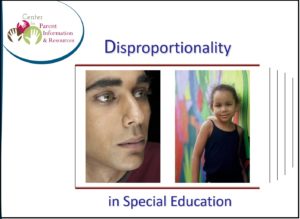A training module series
of the Center for Parent Information and Resources
November 2020
 IDEA 2004 takes a stand against significant disproportionality of students in particular racial or ethnic groups in special education. This training module explains what disproportionality is, which students are most often affected, and the consequences disproportionality can and does have, especially on students with disabilities. What does IDEA require states, districts, and schools to do to monitor for disproportionality in special education programs? What happens in a state that finds significant disproportionality in the state or in any of its districts/LEAs? What correction actions must be taken? This module answers these questions.
IDEA 2004 takes a stand against significant disproportionality of students in particular racial or ethnic groups in special education. This training module explains what disproportionality is, which students are most often affected, and the consequences disproportionality can and does have, especially on students with disabilities. What does IDEA require states, districts, and schools to do to monitor for disproportionality in special education programs? What happens in a state that finds significant disproportionality in the state or in any of its districts/LEAs? What correction actions must be taken? This module answers these questions.
Background
The Building the Legacy training curriculum on IDEA 2004 included a module focused on Disproportionality and Overrepresentation. Originally written in 2007, that module became inaccurate in 2016 when IDEA’s regulations with respect to disproportionality were changed. Since then, CPIR has worked closely with OSEP to create a 2020 version that reflects the changes made in the law. We are very pleased to connect you with this new version of the training module, renamed as Disproportionality in Special Education. The module has been substantially expanded and includes:
- 2 separate slideshows (one for general audiences and a second best suited for those who are or will be technically involved in monitoring for disproportionality);
- 2 trainer guides (one for each slideshow), and
- handouts for participants.
Please do help yourself below, and download the components you need to learn on your own and/or to train others in what IDEA now requires of states to address the disproportionality of certain racial or ethnic groups in special education.
Back to top
_______________________________

Slideshow 1 on Disproportionality
Use these 26 slides in vivid colors to train audiences about IDEA’s new requirements regarding disproportionality. The modules provides an overview of disproportionality and key aspects of the final regulations on disproportionality published in December 2016. Parent Centers can use this presentation as part of staff development, to inform their Advisory Boards about disproportionality issues nationally and within their state, and to enlist community groups and others in local and state efforts to address disproportionality in special education. Slideshow 1 is intended primarily for use with general audiences with little prior or in-depth knowledge of disproportionality as a national, state, and local concern.
- Slideshow 1 in PowerPoint
- Slideshow 1 in PDF
- Text-only version of Slideshow 1 (to ensure accessibility of the content to individuals with disabilities)
Trainer Guide for Slideshow 1
The Trainer Guide illustrates how each slide operates and provides detailed discussion of the content on each slide. It’s available as a PDF file with thumbnail graphics of the slides and as an accessible Word file (from which you can freely copy and paste content to other documents). Which would you like?
Handouts for Participants | Slideshow 1
Handout 1: Sketching Out the Scene (Opening Activity)
Handout 1 in PDF | Handout 1 in Word
Handout 2: Congressional Findings (1 page, optional)
Handout 2 in PDF | Handout 2 in Word
Handout 3: Final IDEA Regulations on Disproportionality (§300.646 and §300.647)
Handout 3 in PDF | Handout 3 in Word
Handout 4: Action Steps for Parents of Children with Disabilities (4 pages)
Handout 4 in PDF | Handout 4 in Word
Handout 5: Action Steps for Parent Leadership Groups and Community Organizations (2 pages)
Handout 5 in PDF | Handout 5 in Word
Handout 6: Action Steps for Educators and School Administrators (2 pages)
Handout 6 in PDF | Handout 6 in Word
Handout 7: Circle-Square-Triangle (2 pages)
Handout 7 in PDF | Handout 7 in Word
Handout 8: Resources of More Information
Handout 8 in PDF | Handout 8 in Word
 Slideshow 2 on Disproportionality
Slideshow 2 on Disproportionality
Slideshow 2 picks up where Slideshow 1 left off, with a brief recap of the disproportionality regulations released by the Department in December 2016. The slideshow then looks closely at what the regulations require states to monitor and report every year to the U.S. Department of Education, how disproportionality is to be measured by states (via risk ratio analysis using the standard methodology set forth in the 2016 regulations), and what happens if a state finds significant disproportionality in its own special education practices or in any of its LEAs.
Technical! Use this slideshow with participants who are already knowledgeable about disproportionality as a concern but who need to have a deeper understanding of how disproportionality is determined and what must be done upon findings of significant disproportionality.
- Slideshow 2 in PowerPoint
- Slideshow 2 in PDF
- Text-only version of Slideshow 2 (to ensure accessibility of the content to individuals with disabilities)
Trainer Guide for Slideshow 2
The Trainer Guide for the second slideshow illustrates how each slide operates and provides detailed discussion of the content on each slide. It’s available as a PDF file with thumbnail graphics of the slides and as an accessible Word file (from which you can freely copy and paste content to other documents). Which would you like?
- PDF | Trainer Guide for Slideshow 2
- Word | Trainer Guide for Slideshow 2 (Accessible Word file)
Handouts for Participants | Slideshow 2
Handout 3: Final IDEA Regulations on Disproportionality (Also a handout in Slideshow 1)
Handout 3 in PDF | Handout 3 in Word
Handout 8: Resources of More Information (Also a handout in Slideshow 1)
Handout 8 in PDF | Handout 8 in Word
Handout 9: Let’s Recap (Optional review of the content in Slideshow 1)
Handout 9 in PDF | Handout 9 in Word
Handout 10: Calculating Risk Ratios (optional)
Handout 10 in PDF | Handout 10 in Word
Handout 11: Circle-Square-Triangle Redux (2 pages, not the same as Handout 7!)
Handout 11 in PDF | Handout 11 in Word
__________________________
Please remember that these materials are designed to be authoritative sources of information about disproportionality and overrepresentation. That’s why they are so detailed. As a trainer, you are free to adapt these materials to fit the purposes and needs of your audience, and the amount of time you have to spend with them.
____________________________________
Quick-Jump Menu to Other Modules
1: Top 10 Basics of Special Education
2: Key Changes in IDEA
5: Disproportionality in Special Education (you’re already here!)
6: Early Intervening Services and Response to Intervention
7: Highly Qualified Teachers (withdrawn with the reauthorization of NCLB as the ESSA in 2015)
8: NIMAS
9: Introduction to Evaluation under IDEA
10: Initial Evaluation and Reevaluation
11: Identification of Children with Specific Learning Disabilities
12: The IEP Team
13: Content of the IEP
14: Meetings of the IEP Team
15: LRE Decision Making
16: Children Enrolled by Their Parents in Private Schools
17: Introduction to Procedural Safeguards
18: Options for Dispute Resolution
19: Key Issues in Discipline

